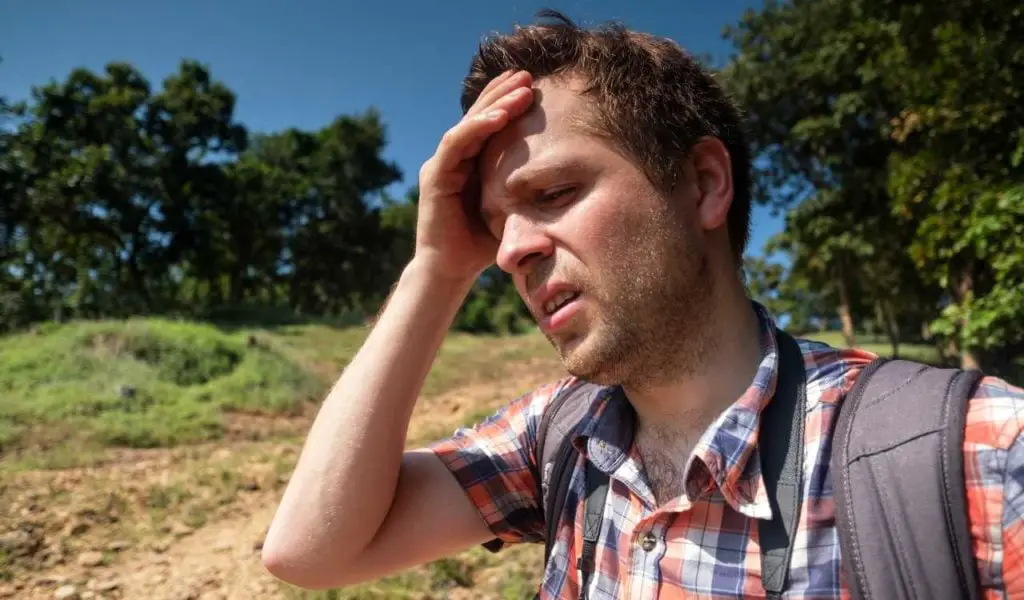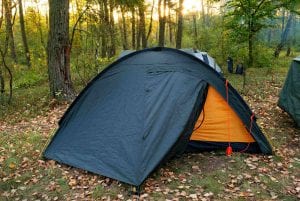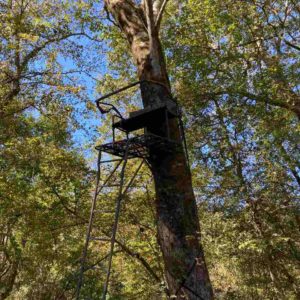
Summer camping trips are a tricky thing to get right. One minute you’re living your best life with a cold beer and a pair of aviators, but then the mercury climbs those few degrees higher and suddenly you’re panting in the shade and lying awake at night in a pool of your own sweat.
Nobody enjoys this. And how to stay cool while camping is a question a lot of folk ask themselves. So, we’ve pulled together 30 of the best tips to help you stay cool and comfortable when the sun’s hot enough to fry an egg on your car hood.
Summary
- Location is important. Try to avoid the summer heat by pitching your tent in a shady, breezy spot with water nearby.
- Pick the right shelter. You’ll want a well-ventilated tent, or you could even consider alternatives like hammocks, tarps, and mesh cots.
- If it’s not going to rain, you can remove your rain fly to improve ventilation or use a reflective sunshade to keep the heat off.
- You can cool a tent using portable A/C units or battery-powered fans.
- Trouble getting to sleep? Try switching your sleeping bag for a lightweight sheet, or laying damp cloths over your pulse points.
- For summer camping in hot temperatures, wear loose clothing, eat light meals, swim as often as you can, and remember to stay hydrated.
Location

Set Up Your Tent in the Shade
Keeping the sun off your tent is one of the best ways to keep it cool. Try and pick a shady spot, and consider how the sun will move during the day.
Just remember that if you’re camping near trees you should beware of falling branches.
Check for dead or diseased limbs and have a good look for “widowmakers” (large branches that are already detached from the tree but are tangled up and haven’t fallen yet). Be especially cautious of trees that are prone to Sudden Branch Drop Syndrome — such as oaks, cottonwoods, eucalyptus, and sycamore.
Pitch in a Breeze
A breeze will help keep you cool, so camping on slightly higher and more exposed ground can be a good plan in the hotter months. Just keep an eye on the weather forecast and make sure you’re not out in the open when there’s a storm rolling in.
Camp Near Water

Bodies of water can cool the areas around them, but — more importantly — camping near a lake or stream lets you take a refreshing dip and gives you plenty of fresh water for cooking. But remember that bugs love to hang around near water too, so pack your Deet and mosquito nets.
Shelter
Choose a Tent With Plenty of Ventilation
Serious mountain tents are often built to keep the elements out, but that’s not really what you want when you’re camping in the summer heat.
The more vents, flaps and doors you can open, the better the air flow and the cooler the tent will be.
Some of the best tents for staying cool while camping are airy cotton tipis/bell tents where you can roll up the side panels to let the air waft right through.
Choose a Tent With Lots of Mesh
Tents with mesh panels are great for hot days and nights. They let the air circulate but also keep bugs from joining the party.
Choose a Lighter-Colored Tent
Dark colors absorb heat more readily, so while a dark green tent might blend into the landscape better, a white or yellow one will stay a lot cooler under direct sunlight.
Check the Weather and Remove Your Rainfly
Though it’s designed to keep water out, a fly will also trap heat inside your tent. If you’re in for a dry night, you can remove it to keep the tent much cooler.
Use a Tarp Instead of a Rainfly
In calm conditions, a tarp will do the same job as a fly — but it’s a much airier set-up which should help you stay cool while camping. Obviously you need something to string the tarp between (whether that’s trees or tarp poles), and it’s not so weatherproof if the wind picks up.
Don’t Use a Tent at All
Nobody ever said that a summer camping trip means tent camping! Instead of using a tent, you could try a totally different camping set-up by sleeping on a mesh cot under a bug net and a tarp.
You’ll be completely open to the (hopefully) cool air, both above and below, while also getting some weather protection from the tarp.
Try a Hammock

Seasoned hammock campers love to evangelize about life as a tree-dweller, and there’s a lot to recommend it in hot weather.
The air can circulate all around you, and you can combine it with a bug net and/or tarp for protection from weather and insect bites.
Obviously this works better for solo campers than families, and you’ll also need trees to sling yourself between.
Take Your Tent Down During the Day
The heat of the day can turn your tent into an oven — one way to get around this is to strike your tent in the morning and store it in the shade until dusk.
The obvious downside of this is that it can be a lot of effort packing and unpacking tents. Particularly larger ones.
Insulate Yourself From the Ground Heat
It sounds counter-intuitive, but an insulated camping mat doesn’t just stop cold from the ground seeping into your bones as you sleep.
In really hot places, the ground can hold a lot of heat after a sunny day, so by raising yourself above it on a cushion of air or foam, you can keep yourself a little cooler. A mesh cot is even better if you’ve got the space.
How to Cool a Tent
Get a Portable Fan

Even just a personal battery-powered fan can give you some relief on hot nights. You could also get a specific tent fan for even better air circulation. (If you’ve got a decent power source, a larger camping fan can make all the difference).
Add Some Ice
If you’ve brought a cooler — or if there’s a store nearby where you can pick up the basics — placing a tray of ice cubes in front of your fan can really cool down hot air. It’s not exactly air conditioning but this sort of homemade tent cooler can take a camping fan to the next level.
Try Portable A/C
Some air-conditioners are small enough to fit in a tent, and will make a huge difference helping larger tents stay cool. The downside, of course, is that they’re very power-hungry, so you’ll need utility power to run them (and probably an extension cord, too).
An alternative is to use a portable evaporative cooler. These work a lot like an air conditioner but they use plain old water rather than refrigerant. They don’t produce as much cold air as a true air conditioner, but you can get compact, battery-powered ones that will give you up to ten hours of fresh air off a full charge.
Use a Reflective Sunshade
One way to cool a tent is to stop it from heating up in the first place. A reflective sunshade is like a rain tarp that you string up above your tent during daylight hours to reflect the sunlight away from it, helping it stay cool.
An added bonus is that this could prolong the life of your tent, since UV damage degrades tent fabrics quicker than just about anything else.
Bring Your Cooler Into the Tent
If you’re really in trouble and can’t get to sleep, you might have to resort to bringing your cooler into the tent. This can help lower the air temperature, but the inevitable downside is that it will stop keeping your food cool. All the same, sometimes needs must…
Sleeping
Try to Sleep While It’s Dark
It sounds obvious, but your tent will be hotter when the sun’s on it. Many a camper has tried to enjoy a lie-in after a late night sinking beers around the firepit, only to be forced outside as the morning sun turns the tent into a broiler.
Part of the joy of camping is that it gives you a chance to re-align your natural rhythms, and going to bed with the sun will help keep you both cool and well-rested.
Lay a Cooling Towel Across Your Forehead or Neck
When you’re really struggling with the heat, soak a towel in cold water, wring it out, and place it over your forehead or neck. Putting cold compresses on your wrists or the small of your back can work well too. You’ll find the cooling effect most pleasant!
Take a Cold Shower or a Swim Before Going to Sleep
Anyone who’s camped in cold conditions knows that the trick is to crawl into your sleeping bag warm, rather than trying to get warm when you’re already cold.
In hot weather, the same applies but in reverse — a cold shower or a refreshing dip in the cool water of a lake before you fall asleep will bring down your body temperature and get you off to a good start on stuffy nights.
Leave the Three-Season Sleeping Bag at Home

Cold-weather sleeping bags obviously aren’t appropriate for baking hot nights, and a much lighter summer bag could be a better option.
However, before you leave the warmer bag back in your closet, be sure to check the night-time temperatures at your camping destination. Some environments — like deserts or mountains — can be searing hot during the daytime and cold when the hot sun goes down.
Use a Sheet or Blanket Instead of a Sleeping Bag
Sometimes you won’t even need a full sleeping bag. Cooler alternatives could include a light fleece blanket or a cotton/silk liner.
Food and Drink
Use Coolers
If you’re camping in a fixed location rather than backpacking, it makes sense to bring a cooler. This can be anything from a fancy electric one to a simple insulated box that you chill with ice from the store.
It’ll keep your food fresh and safe in hot conditions, and also means you can cool off with a refreshing cold beer or soda if the tent’s getting too hot.
Don’t Eat Just Before Bed
Digestion produces a small amount of body heat, and some people suggest that leaving a couple hours between eating and going to bed can help you stay cool as you try to get to sleep.
Ease Off on the Firepits and BBQs

Everyone loves a bit of campfire cooking, but slaving over hot coals is a surefire way to work up a sweat. Plus heavy, meaty dishes can make you feel sluggish in hot weather.
As the temperature rises, you might want to eat more cold meals like salads, wraps, cereals, and fruit.
Stay Hydrated
Drinking water won’t cool your tent, but it will help your body cool itself effectively. Eight to ten glasses of water a day (or about a gallon) is the ballpark target, but you’ll need to increase this in really hot weather, in situations where you’re exercising hard, or when you’re drinking alcohol.
Clothing
Loose and Long
For hot-weather camping, you’ll want to wear loose-fitting garments that let the air circulate.
Though it’s tempting to opt for shorts and a t shirt, longer lightweight clothing that covers your skin is usually better, since camping in the heat normally comes packaged up with the risk of sunburn and bug bites.
Light colored clothing is better than dark. And a wide brim hat is also an excellent option to protect you from the sun’s rays.
Pick Your Fabrics
Cotton can be cool and airy but it’s also slow-drying and doesn’t wick moisture away from your skin like other fabrics. Both cotton and synthetics will also start to stink pretty quickly if you’re sweating.
More breathable and odor-resistant alternatives include merino wool or bamboo.
Soak a Bandana
To cool yourself down as you move around your campsite, try soaking a bandana in cold water and wrapping it round your head or neck. (Evaporative cooling, ain’t it!).
Switch Your Footwear
Don’t forget to keep your feet cool too! While boots or shoes with waterproof membranes are great for cold and wet conditions, they’ll start to get mighty uncomfortable in stifling temperatures.
Many people switch to sandals in hotter weather, but other alternatives include mesh sneakers, espadrilles, or deck shoes. Also growing in popularity are eastern-style outdoor slippers like Sabahs or Mohinders City Slippers.
FAQs
How Can I Keep My Tent Cool in the Summer?
When tent camping, pick a location that’s shady and breezy. Ventilate your tent by rolling up side panels and opening the tent door. If there’s no risk of rain — remove the rain fly.
Some people cool larger tents using portable A/C units, evaporative coolers, or battery-powered fans. And there are dozens of other ways of staying cool while camping.
How Do You Camp in Hot Weather?
Summer camping in hot weather is all about helping yourself and your tent stay cool. Wear loose clothing, eat light meals, and drink plenty of liquid. Take dips in lakes or pools if you can. Tweak your sleep system by using mesh cots or lightweight silk sleeping bags. And check out all the other tips in this article to help you stay cool while camping.
How Can I Cool My Tent Without Electricity?
There are a number of ways to cool your tent without electricity while summer camping. Some fans or evaporative coolers are battery-powered, meaning you can use them without the power grid. However, the best way to keep a tent cool while camping in the heat is to pitch it in the shade and keep it well ventilated.
How Hot Is Too Hot For Camping?
Staying cool while camping in anything above 95°F is going to be tricky. Temperatures above 105°F can be really dangerous. And so depending on your comfort levels, anything from 95°F is possibly too hot for camping.
What to Wear When Camping in Hot Weather?
For camping in hot weather, you’ll ideally want loose, long clothing in breathable fabrics such as merino or bamboo. For footwear, avoid heavier shoes with waterproof membranes and go for sandals or light sneakers instead. When it comes to clothing, one of the best summer camping tips is to wear light colors.






